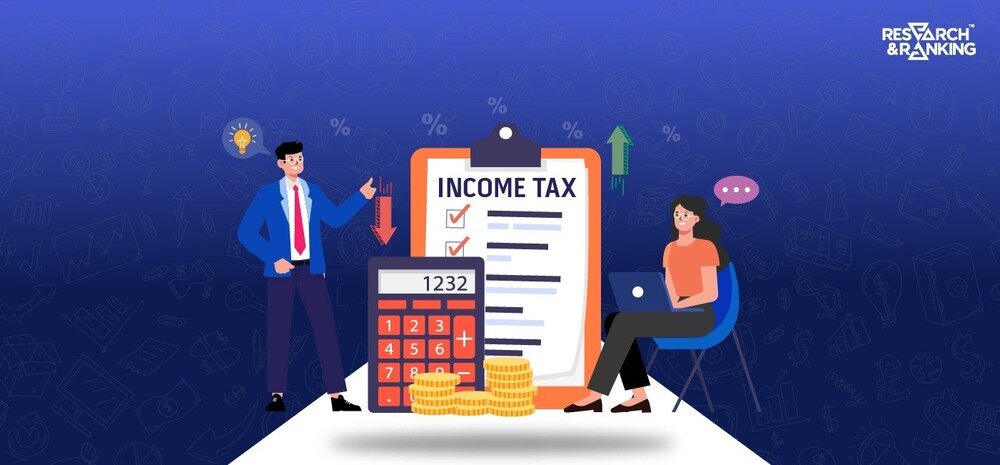Income tax applies to all salaried employees in the country. However, the nitty-gritty of how to calculate income tax on salary can be overwhelming, especially for first-timers.
From understanding income tax slabs to deciphering different applicable deductions and exemptions, all these details are necessary to calculate tax on taxable income.
In this blog, we will discuss how income tax is calculated and walk you through a detailed example. This will give you a fair idea of what is considered when calculating income tax.
Relation between Income Tax and Taxable Income
Before we discuss how income tax is calculated, it is crucial to understand the difference between earned income and taxable income.
- Earned income is the total annual salary, including income from salaries, house property, business, capital gains, and other sources.
- Taxable income is calculated by subtracting tax exemptions, deductions, and rebates. You can use the tax loss harvesting strategy for long-term investments to reduce income tax.
How is Income Tax Calculated?
Determine your Gross Salary
The first step is to determine your gross salary to know how income tax is calculated. To do so, add up the following salary components.
- Basic Salary
- House Rent Allowance (only valid if you can submit proof of living on rent)
- Leave Travel Allowance
- Mobile Allowance
- Special Allowance
- Bonuses
- Overtime payments
- Income from other sources like house property gains, dividends, stocks,
Subtract Deductions for Taxable Income
To calculate income tax on salary, you must subtract the net salary from the gross salary. Here are all the deductions that are eligible for income tax.
- All salaried employees are entitled to a fixed ₹50,000 deduction per the new income tax regime.
- A taxpayer can claim a tax deduction of up to ₹1.50 lakhs under Section 80C based on their investments. This deduction helps you assess how to pay less tax as it reduces the taxable income.
The investments can include Equity-Linked Savings Schemes, Employees’ Provident Funds, Public Provident Funds, and Mutual Funds.
- All deductions under Section 57(IIA).
Taxable Income = Gross Salary – Standard Deduction (₹50,000) – HRA – Other Deductions
After removing the necessary deductions, you get your taxable income. Next, you must learn how income tax is calculated on this new taxable income.
Determine Applicable Income Tax Slab
The next step in calculating income tax is to assess and evaluate which income tax slab your taxable income falls into to determine the tax rate.
| Income Tax Slabs (in ₹) | New Regime Tax Rate (%) |
| Up to 2.5 lakhs | – |
| 2.5 lakhs to 5 lakhs | 5% |
| 5 lakhs to 7.5 lakhs | 10% |
| 7.5 lakhs to 10 lakhs | 15% |
| 10 lakhs to 12.5 lakhs | 20% |
| 12.5 lakhs to 15 lakhs | 25% |
| Above 15 lakhs | 30% |
| Up to 60 years of age | |
| Up to 2.5 Lakhs | Nil |
| 2.5 Lakhs to 5 Lakhs | 5% |
| 5 Lakhs to 10 Lakhs | 20% |
| Above 10 Lakhs | 30% |
| Senior Citizens (60-79 years) | |
| Up to 3 Lakhs | Nil |
| 3 Lakhs to 5 Lakhs | 5% |
| 5 Lakhs to 10 Lakhs | 20% |
| Above 10 Lakhs | 30% |
| Super Senior Citizens (80 years and above) | |
| Up to 5 Lakhs | Nil |
| 5 Lakhs to 10 Lakhs | 20% |
| Above 10 Lakhs | 30% |
Calculate Taxes
Based on the taxable income calculation and slab recognition, you must apply the valid tax rate to calculate the tax on taxable income for the final tax liability.
Income Tax Calculation Example for New Regime
To understand how income tax is calculated, let us look at the example of Ms. Rashi Gupta below.
Ms. Rashi Gupta earns an annual income of ₹12,00,000 and lives in a metropolitan city.
Let us learn how to calculate income tax on salary for Ms. Rashi.
| Components | Old Regime | New Regime |
| Gross Salary | ₹12,00,000 | ₹12,00,000 |
| Standard Deduction | ₹50,000 | ₹50,000 |
| Deductions Under Section 80C (for Life Insurance Premiums, investments toward ELSS, PPF/SPF/RPF, NSC, etc. ) (Max Limit Up to ₹1.5 lakhs) | ₹1,00,000 | – |
| Income From Other Sources (Interest Income from a Bank) | ₹12,000 | ₹12,000 |
| Final Taxable Income | 10,28000 | 11,28,000 |
| Tax Liability Calculation | ||
| Tax Under Normal Rates | ₹1,31,100 | ₹84,300 |
| Health and Education Cess (4%) | 4% of ₹1,31,100 = ₹5244 | 4% of ₹84,300 = 3372 |
| Income Tax Liability | ₹1,36,344 | ₹87627 |
According to the illustration above, Ms. Rashi pays more under the old regime scheme based on the tax slabs and deductions permitted under that scheme. However, her tax liability is lesser when she chooses the new income tax regime.
Conclusion
Knowing how income tax is calculated on your earned income is necessary to assess your tax liability. Additionally, it is crucial to understand the different applicable deductions and exemptions to help you reduce your tax liability.
Investments offer significant deductions; thus, spending extra time on stock, share, and equity portfolio management is the need of the hour. For added assistance, you can always consult a SEBI-registered advisory that offers maximum support through daily reporting and stock management.
FAQ On Income Tax
What is the formula for calculating income tax?
The formula for calculating income tax involves subtracting deductions and exemptions from your gross total income to arrive at your taxable income. Then, apply the applicable tax rates based on your choice of tax regime and the income tax slabs you fall under. Finally, add cess and surcharge, if applicable, to determine your total tax liability.
How much tax will I pay if my salary is 10 lakh?
If your salary is ₹10 lakhs, your tax depends on the tax regime you opt for. Under the new regime, your tax liability would be approximately ₹78,000 (including cess at 4% on tax). This is calculated based on the slab rates of 5%, 10%, and 15% for different portions of your income up to ₹10 lakhs.
So the calculation would be,
Income Tax Liability = Final Taxable Income + Education and Healthcare Cess (4%)
Final Taxable Income = ₹75000
Education and Healthcare Cess (4%) = ₹3000
Income Tax Liability = ₹75000 + ₹3000 = ₹78,000Which salary is tax-free?
Under the old tax regime, salaries up to ₹2.5 lakhs per annum are tax-free for individuals under 60. For senior citizens (aged 60-79), incomes up to ₹3 lakhs are exempt, and for super senior citizens (aged 80 and above), the exemption limit is ₹5 lakhs. Any income below these thresholds does not attract income tax.
Under the new tax regime, salaries up to ₹3 lakhs per annum are tax-free.
How useful was this post?
Click on a star to rate it!
Average rating 5 / 5. Vote count: 2
No votes so far! Be the first to rate this post.
waitfor delay '0:0:5'--
I’m Archana R. Chettiar, an experienced content creator with
an affinity for writing on personal finance and other financial content. I
love to write on equity investing, retirement, managing money, and more.
 Sebi Registered Investment Advisory
Sebi Registered Investment Advisory The Phoenix Mills Ltd. (PDF)
The Phoenix Mills Ltd. (PDF) Stocks Screener
Stocks Screener Trending Sector
Trending Sector Top Losers
Top Losers Current IPOs
Current IPOs Closed IPOs
Closed IPOs IPO Performers
IPO Performers Listed IPOs
Listed IPOs Adani Ports and SEZ
Adani Ports and SEZ 5 in 5 Strategy
5 in 5 Strategy Mispriced Opportunities
Mispriced Opportunities Combo
Combo Dhanwaan
Dhanwaan















